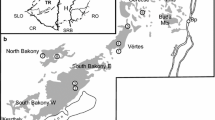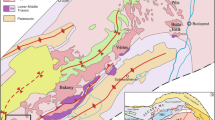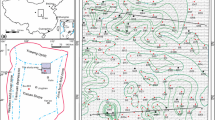Abstract
Dolomitization of platform carbonates is commonly the result of multiphase processes. Documentation of the complex dolomitization history is difficult if completely dolomitized sections are studied. Two Middle Anisian sections representing two coeval carbonate platforms were investigated and compared in the present study. Both sections are made up of meter-scale peritidal–lagoonal cycles with significant pedogenic overprint. One of the sections contains non-dolomitized, partially dolomitized, and completely dolomitized intervals, whereas the other is completely dolomitized. Based on investigations of the partially dolomitized section, penecontemporaneous dolomite formation and/or very early post-depositional dolomitization were identified in various lithofacies types. In shallow subtidal facies, porphyrotopic dolomite was found preferentially in microbial micritic fabrics. Microbially induced dolomite precipitation and/or progressive replacement of carbonate sediments could be interpreted for stromatolites. Cryptocrystalline to very finely crystalline dolomite, probably of pedogenic origin, was encountered in paleosoil horizons. Fabric-destructive dolomite commonly found below these horizons was likely formed via reflux of evaporated seawater. As a result of the different paleogeographic settings of the two platforms, their shallow-burial conditions were significantly different. One of the studied sections was located at the basinward platform margin where pervasive fabric-retentive dolomitization took place in a shallow-burial setting, probably via thermal convection. In contrast, in the area of the other, smaller platform shallow-water carbonates were covered by basinal deposits, preventing fluid circulation and accordingly pervasive shallow-burial dolomitization. In the intermediate to deep burial zone, recrystallization of partially dolomitized limestone and occlusion of newly opened fractures and pores by coarsely crystalline dolomite took place.













Similar content being viewed by others
References
Alonso-Zarza AM, Wright VP (2010) Calcretes. In: Alonso-Zarza AM, Tanner LH (eds) Carbonates in continental settings, developments in sedimentology, vol 61. Elsevier, Amsterdam, Oxford, pp 225–267
Alonso-Zarza AM, Wright VP, Calvo JP, Garcia del Cura MA (1992) Soil–landscape and climatic relationships in the Middle Miocene of the Madrid Basin. Sedimentology 39:17–35
Alonso-Zarza AM, Sanz ME, Calvo JP, Estévez P (1998) Calcified root cells in Miocene pedogenic carbonates of the Madrid Basin: evidence for the origin of Microcodium b. Sedim Geol 16:81–97
Baltzer F, Kenig F, Boichard R, Plaziat J-C, Purser BH (1994) Organic matter distribution, water circulation and dolomitization beneath the Abu Dhabi Sabkha (United Arab Emirates). In: Purser BH, Tucker ME, Zenger DH (eds) Dolomites, vol 21. IAS Spec Publ, pp 409–427
Bazargani-Guiliani K, Faramarzi M, Tak MAN (2010) Multistage dolomitisation in the Cretaceous carbonates of the east Shahmirzad area, north Semnan, central Alborz, Iran. Carbonates Evaporites 25:177–191
Bontognali TRR, Vasconcelos C, Warthmann RJ, Dupraz Ch, Bernasconi SM, McKenzie JA (2008) Microbes produce nanobacteria-like structures, avoiding cell entombment. Geology 36:663–666
Bontognali TRR, Vasconcelos C, Warthmann RJ, Bernasconi SM, Dupraz Ch, Strohmenger ChJ, McKenzie JA (2010) Dolomite formation within microbial mats in the coastal sabkha of Abu Dhabi (United Arab Emirates). Sedimentology 57:824–844
Budai T, Haas J (1997) Triassic sequence stratigraphy of the Balaton Highland (Hungary). Acta Geol Hung 40:307–335
Budai T, Vörös A (1992) Middle Triassic history of the Balaton Highland: extensional tectonics and basin evolution. Acta Geol Hung 35:237–250
Budai T, Vörös A (2003a) Geological setting. In: Vörös A (ed) The Pelsonian Substage at the Balaton Highland (Middle Triassic, Hungary), vol 55, Geol Hung ser Palaeontol, pp 9–11
Budai T, Vörös A (2003b) The Pelsonian basin evolution. In: Vörös A (ed) The Pelsonian Substage at the Balaton Highland (Middle Triassic, Hungary), vol 55. Geol Hung ser Palaeontol, pp 45–46
Budai T, Vörös A (2006) Middle Triassic platform and basin evolution of the Southern Bakony Mountains (Transdanubian Range, Hungary). Riv Ital Paleontol Stratigr 112:359–371
Budai T, Lelkes Gy, Piros O (1993) Evolution of Middle Triassic shallow-marine carbonates in the Balaton Highland (Hungary). Acta Geol Hung 36:145–165
Budai T, Császár G, Csillag G, Dudko A, Koloszár L, Majoros Gy (1999) Geology of the Balaton Highland. Explanation to the Geological Map of the Balaton Highland, 1:50,000. Occas Papers Geol Inst Hungary 197:169–257
Budd DA (1997) Cenozoic dolomites of carbonate islands: their attributes and origin. Earth Sci Rev 42:1–47
Chafetz HS (1986) Marine peloids: a product of bacterially induced precipitation of calcite. J Sed Petrol 56:812–817
Chen D, Quing H, Yang C (2004) Multistage hydrothermal dolomites in the Middle Devonian (Givetian) carbonates from the Guilin area, South China. Sedimentology 51:1029–1051
Choquette PW, Hiatt EE (2007) Shallow burial dolomite cement: a major component of many ancient sucrosic dolomites. Sedimentology 55:423–460
Di Cuia R, Riva A, Scifoni A, Moretti A, Spötl Ch, Caline B (2011) Dolomite characteristics and diagenetic model of the Calcari Grigi Group (Asiago Plateau, Southern Alps—Italy): an example of multiphase dolomitisation. Sedimentology 58:1347–1369
Dickson JAD (1966) Carbonate identification and genesis as revealed by staining. J Sed Petrol 36:491–505
Fischer AG (1964) The Lofer cyclothems of the Alpine Triassic. Kansas Geol Surv Bull 169:107–149
Fu Q, Quing H (2011) Medium and coarsely crystalline dolomites in the Middle Devonian Ratner Formation, southern Saskatchewan, Canada: origin and pore evolution. Carbonates Evaporites 26:111–125
Goudie AS (1983) Calcrete. In: Goudie AS, Pye K (eds) Chemical sediments and geomorphology, pp 91–131
Haas J (1985) Senonian palaeogeographic relations of the Transdanubian Central Range. Annu Rep Hung Geol Surv 1983:95–109
Haas J (2004) Characteristics of peritidal facies and evidences for subaerial exposures in Dachstein-type cyclic platform carbonates in the Transdanubian Range, Hungary. Facies 50:263–286
Haas J (ed) (2012) Geology of Hungary, p 244
Haas J, Budai T (1995) Upper Permian—Triassic facies zones in the Transdanubian Range. Riv Ital Paleontol Stratigr 101:249–266
Haas J, Budai T (1999) Triassic sequence stratigraphy of the Transdanubian Range, Hungary. Geol Carpath 50(6):459–475
Haas J, Budai T, Raucsik B (2012) Climatic controls on sedimentary environments in the Triassic of the Transdanubian Range (western Hungary). Palaeogeogr Palaeoclimatol Palaeoecol 353–355:31–44
Jones B, Luth RW (2003) Temporal evolution of Tertiary dolostones on Grand Cayman as determined by 87Sr/86Sr. J Sed Res 73:187–205
Jones GD, Xiao Y (2005) Dolomitization, anhydrite cementation, and porosity evolution in a reflux system: insight from reactive transpost models. AAPG Bulletin 80:577–601
Korte Ch, Kozur HW, Veizer J (2005) δ13C and δ18O values of Triassic brachiopods and carbonate rocks as proxies for coeval seawater and palaeotemperature. Palaeogeogr Palaeoclimatol Palaeoecol 226:287–306
Machel HG (2004) Concepts and models of dolomitization: a critical reappraisal. In: Braithwaite CJR, Rizzi G, Darke G (eds) The geometry and petrogenesis of dolomite hydrocarbon reservoirs, vol 235. Geol Soc (London) Spec Publ, pp 7–63
Mazzullo SJ, Reid AM, Gregg JM (1987) Dolomitization of Holocene Mg-calcite supratidal deposits, Ambergis Cay, Belize. Geol Soc Am Bull 89:224–231
McKenzie JA, Hsü KJ, Schneider JF (1980) Movement of subsurface waters under the sabkha, Abu Dhabi, United Arab Emirates and its relation to evaporative dolomite genesis. SEPM Spec Publ 28:11–30
Melim LE, Swart PS, Maliva RG (2001) Meteoric and marine-burial diagenesis in the subsurface of Great Bahama bank. In: Ginsburg RN (ed) Subsurface geology of a prograding carbonate platform margin, Great Bahama Bank: results of the Bahamas drilling project, vol 70. SEPM Spec Publ, pp 137–161
Nader FH, Swennen R, Ellam R (2004) Reflux stratabound dolostone and hydrothermal volcanism-associated dolostone: a two-stage dolomitisation model (Jurassic, Lebanos). Sedimentology 51:339–360
Read JF, Horbury AD (1993) Eustatic and tectonic controls on porosity evolution beneath the sequence-bounding unconformities and parasequence disconformities on carbonate platforms. In: Horbury AD, Robinson AG (eds) Diagenesis and basin development Am Ass Petrol Geol, Studies in Geology, vol 36. pp 155–197
Riding R (2000) Microbial carbonates: the geological record of calcified bacterial-algal mats and biofilms. Sedimentology 47:179–214
Riding R (2002) Biofilm architecture of Phanerozoic cryptic carbonate marine veneers. Geology 30:31–34
Rosenbaum J, Sheppard SMF (1986) An isotopic study of siderites, dolomites and ankerites at high temperatures. Geochim Cosmochim Acta 50:1147–1150
Sánchez-Román M, Vasconcelos C, Schmid Th, Dittrich M, McKenzie JA, Zenobi R, Rivadeneyra MA (2008) Aerobic microbial dolomite at the nanometer scale: implications for the geologic record. Geology 36:879–882
Scholle PA, Kinsman DJJ (1974) Aragonite and high-Mg calcite caliche from the Persian Gulf—a modern analog for the Permian of Texas and New Mexico. J Sed Petrol 44:904–916
Shinn EA (1983) Tidal flat environment. In: Schole PA, Bebout DG, Moore CH (eds) Carbonate depositional environments, vol 33. Mem Am Ass Petrol Geol, pp 173–210
Sibley DF, Gregg JM (1987) Classification of dolomite rock textures. J Sed Petrol 57:967–975
Spadafora A, Perri E, McKenzie JA, Vasconcelos C (2010) Microbial biomineralization processes forming modern Ca:Mg carbonate stromatolites. Sedimentology 57:27–40
Spötl C, Pitman JK (1998) Saddle (baroque dolomite) in carbonates and sandstones: a reappraisal of a burial diagenetic concept. IAS Spec Publ 26:437–460
Spötl C, Vennemann TW (2003) Continuous-flow isotope ratio mass spectrometric analysis of carbonate minerals. Rapid Comm Mass Spectr 17:1004–1006
Tucker ME, Wright VP (eds) (1990) Carbonate sedimentology, p 482
Vasconcelos C, Warthmann R, McKenzie JA, Vissher PT, Bittermann AG, van Lith Y (2006) Lithifying microbial mats in Lagoa Vermelha, Brazil: modern Precambrian relics? Sed Geol 185:175–183
Vörös A, Galácz A (1998) Jurassic palaeogeography of the Transdanubian Central Range. Riv Ital Paleontol Stratigr 104:69–83
Vörös A, Budai T, Kovács S, Piros O, Szabó I (2003) Stratigraphy. In: Vörös A (ed) The Pelsonian Substage at the Balaton Highland (Middle Triassic, Hungary) Geol Hung ser Palaeontol, vol 55. pp 45–46
Whitaker FF, Smart PL (1993) Circulation of saline groundwaters in carbonate platforms: a review and case study from the Bahamas. In: Horbury AD, Robinson AG (eds) Diagenesis and basin development, Am Ass Petrol Geol, Studies in Geology, vol 36. pp 113–132
Whitaker FF, Xiao Y (2010) Reactive transport modeling of early burial dolomitization of carbonate platforms by geothermal convection. AAPG Bull 94:889–917
Wright DT (1997) An organogenic origin for widespread dolomite in the Cambrian Eilean Dubh Formation, Northwestern Scotland. J Sed Res 67:54–64
Wright DT (2000) Benthic microbial communities and dolomite formation in marine and lacustrine environments—a new dolomite model. In: Glen CR, Prévôt-Lucas L, Lucas J (eds) Marine authigenesis: from global to microbial. SEPM Spec Publ, vol 66. pp 7–20
Wright VP (2007) Calcrete. In: Nash DJ, McLaren SJ (eds) Geochemical sediments and landscapes, pp 10–47
Wright D, Wacey D (2005) Precipitation of dolomite using sulphate-reducing bacteria from the Coorong Region, south Australia: significance and implications. Sedimentology 52:987–1008
Acknowledgments
The authors are indebted to Olga Piros for determination of the dasycladalean algae and to Henry Lieberman (Houston) for the linguistic correction of the paper. The editorial guidance of Maurice E. Tucker, furthermore the detailed comments and suggestions of the reviewers Jay M. Gregg and Paulo Boggiani improved the manuscript considerably. The present study was supported by the Hungarian National Science Fund (OTKA) grant K 81296 (J. Haas).
Author information
Authors and Affiliations
Corresponding author
Rights and permissions
About this article
Cite this article
Haas, J., Budai, T., Győri, O. et al. Similarities and differences in the dolomitization history of two coeval Middle Triassic carbonate platforms, Balaton Highland, Hungary. Facies 60, 581–602 (2014). https://doi.org/10.1007/s10347-014-0397-1
Received:
Accepted:
Published:
Issue Date:
DOI: https://doi.org/10.1007/s10347-014-0397-1




